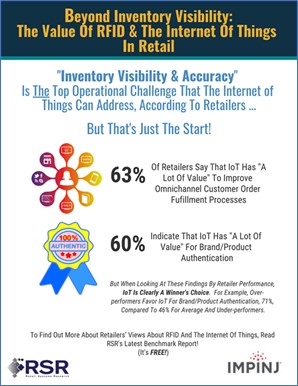What About… RFID?
The RSR team announced its 2023 benchmark research agenda in a webinar a couple of weeks ago (to view the replay, click this link: https://vimeo.com/797817413). Typically after we announce our benchmark schedule, we get a lot of “What about…” questions, and this year was no exception. What about ChatGPT? What about AI? What about crypto? Blockchain? Robotics? etc. They’re all good questions.
Right after the webinar, a retailer-colleague emailed me to ask, “What about RFID?” What probably triggered that question is that in 2022 we focused on IoT and RFID in a benchmark entitled A Deep Dive Into Retailers’ Views About RFID And The Internet Of Things (sponsored by RAIN RFID chip maker, Inpinj). So, the question from the retailer was straightforward: “Are you going to publish an update?”
The answer is, we haven’t forgotten, but have rolled it into a planned 2023 benchmark study that broadens the focus, to be entitled Digital Transformation Of The Retail Business Model. In the webinar, we described the proposed benchmark study this way:
“The idea behind digital transformation is that everything physical can have its ‘digital twin’, and those digital twins can be observed and analyzed in ways that make it possible to hyper-optimize business processes. Which business processes are the best candidates for digital transformation strategies?”
That’s a generalized description that leaves plenty of room to maneuver. But what we can say with confidence is that the challenges and opportunities associated with inventory visibility both in the supply chain and throughout the enterprise will be a top focus for the benchmark – because it’s a top focus for retailers. The 2022 RFID benchmark highlighted that retailers had turned a corner when it comes to IoT technologies in general and RFID, in particular, especially when it comes to controlling inventory. We featured that in the infographic that accompanied the report:

But other benchmarks have also underlined the inventory issue. For example, our recent benchmark on the state of merchandise planning pointed out that inventory visibility remains a top operational challenge for more than 50% of the retailers we surveyed. And that result isn’t confined to one retail vertical – in fact, it’s pervasive:
|
|
FMCG |
GM |
Apparel |
Hard Goods |
|
Getting an accurate picture of our current inventory position |
43% |
52% |
64% |
50% |
Without a current and accurate picture of what inventory is available and where it is, retailers have to either over-inventory to ensure high service levels to consumers, or risk losing sales. Those are lousy choices (even if retailers have been living with them for a long time). On the other hand, current and accurate visibility goes a long way towards making it possible for retailers to both achieve high service levels to consumers and have less paid-for inventory lying around.
And the most effective way to achieve that level of visibility is with digital twin technologies, most notably RFID. That is why some very prominent retailers are forging ahead. Here’s what a few are saying[1]:
Bob Neville, vice president of global retail at Under Armour said, “We don’t see RFID as a nice-to-have, we see it as vital to bringing the retail experience to the next level.” Under Armour is deploying RFID across its 400 stores to gain accurate stock visibility, optimize item availability, and achieve efficiency gains in key day-to-day processes.
At Nike, RAIN RFID tags are added to products at the point of manufacture, allowing them to be tracked from factory to warehouse to store. Mark Parker, executive chair and former CEO of NIKE said, “RFID gives us the most complete view of our inventory that we have ever had. It’s quickly becoming the most precise tool in our arsenal to meet an individual consumer’s specific need at the exact right moment.
Walmart has expanded RFID tagging to items in home goods, sporting goods, electronics, and toys. Matt Alexander, Walmart’s senior director of merchandising transformation recently said, “We look forward to expanding the use of RAIN RFID into more categories to further improve inventory accuracy across the business, provide a better in-store shopping experience for customers, and drive more online and pick-up-in-store capabilities.”
So, what’s the short answer to the question, “What about RFID?” The answer is: it’s on our radar! So be sure to look for report in the Fall of 2023.
